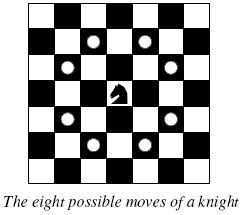POJ 2488 A Knight's Journey (DFS)
A Knight's Journey
| Time Limit: 1000MS | Memory Limit: 65536K | |
| Total Submissions: 30656 | Accepted: 10498 |
Description
 Background
Background The knight is getting bored of seeing the same black and white squares again and again and has decided to make a journey
around the world. Whenever a knight moves, it is two squares in one direction and one square perpendicular to this. The world of a knight is the chessboard he is living on. Our knight lives on a chessboard that has a smaller area than a regular 8 * 8 board, but it is still rectangular. Can you help this adventurous knight to make travel plans?
Problem
Find a path such that the knight visits every square once. The knight can start and end on any square of the board.
Input
The input begins with a positive integer n in the first line. The following lines contain n test cases. Each test case consists of a single line with two positive integers p and q, such that 1 <= p * q <= 26. This represents a p * q chessboard, where p describes how many different square numbers 1, . . . , p exist, q describes how many different square letters exist. These are the first q letters of the Latin alphabet: A, . . .
Output
The output for every scenario begins with a line containing "Scenario #i:", where i is the number of the scenario starting at 1. Then print a single line containing the lexicographically first path that visits all squares of the chessboard with knight moves followed by an empty line. The path should be given on a single line by concatenating the names of the visited squares. Each square name consists of a capital letter followed by a number.
If no such path exist, you should output impossible on a single line.
If no such path exist, you should output impossible on a single line.
Sample Input
3 1 1 2 3 4 3
Sample Output
Scenario #1: A1 Scenario #2: impossible Scenario #3: A1B3C1A2B4C2A3B1C3A4B2C4
Source
TUD Programming Contest 2005, Darmstadt, Germany
题目思路很清晰就是说如果能遍历整个图则打印路径,如果不行,则输出impossible
这道题按照字典序去搜索,想清楚行列关系再写,不然会WA

1 #include<cstdio> 2 #include<cstring> 3 #include<stdlib.h> 4 #include<algorithm> 5 using namespace std; 6 const int MAXN=200+10; 7 const int INF=0x3f3f3f3f; 8 int n,m,flag; 9 int vis[MAXN][MAXN],vx[MAXN],vy[MAXN]; 10 int dir[8][2]={{-2,-1},{-2,1},{-1,-2},{-1,2},{1,-2},{1,2},{2,-1},{2,1}};//字典序 11 void DFS(int x,int y,int sum) 12 { 13 vx[sum]=x;//列,字母 14 vy[sum]=y;//行,数字 15 if(sum==n*m) 16 { 17 flag=1; 18 return ; 19 } 20 for(int i=0;i<8;i++) 21 { 22 int xx=x+dir[i][0]; 23 int yy=y+dir[i][1]; 24 if((1<=xx&&xx<=m)&&(1<=yy&&yy<=n)&&!vis[xx][yy]&&!flag) 25 { 26 vis[xx][yy]=1; 27 DFS(xx,yy,sum+1); 28 vis[xx][yy]=0; 29 } 30 } 31 } 32 int main() 33 { 34 //freopen("in.txt","r",stdin); 35 int kase,cnt=0; 36 scanf("%d",&kase); 37 while(kase--) 38 { 39 flag=0; 40 scanf("%d %d",&n,&m); 41 memset(vis,0,sizeof(vis)); 42 memset(vx,0,sizeof(vx)); 43 memset(vy,0,sizeof(vy)); 44 vis[1][1]=1; 45 DFS(1,1,1); 46 printf("Scenario #%d:\n",++cnt); 47 if(flag) 48 { 49 for(int i=1;i<=n*m;i++) 50 printf("%c%d",'A'+vx[i]-1,vy[i]); 51 printf("\n"); 52 } 53 else 54 printf("impossible\n"); 55 printf("\n"); 56 57 } 58 return 0; 59 }





 浙公网安备 33010602011771号
浙公网安备 33010602011771号